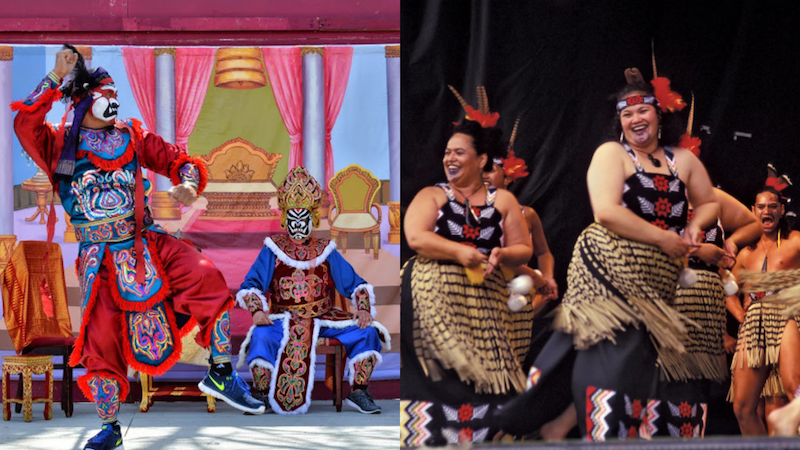
8 More Traditional Theater Practices from Around the World
Theater transforms and transcends, no matter where in the world it may take place. Traditional theater practices in different countries are influenced by history, religion, politics, conflict, and other facts of culture. Theater can be a form of celebration or rebellion, an expression of joy or that of anger. Or even a mix of both, as a true reflection of human life.
For many countries who were colonized by Western powers, their colonial history informs the kind of theater they choose to perform. Some attempt to revive stories and traditions from the pre-colonial era while others have developed a post-colonial form of theater, integrating Western influences with native language and expression. Thus, theater evolves according to the needs of its audience, telling old stories that remain relevant and introducing new stories from recent experience.
Theater can help us make peace with the past, make sense of the present, and make plans for the future.
In celebration of World Theater Day, we’ve put together another list of traditional theater practices around the world, complementing the list we published in 2019.
Here are some more theatrical traditions from around the world:
1. Cambodia: Lakhon Bassac
Lakhon Bassac comes from Lakhon Treoung Klok, a type of an opera show performed in the Bassac region of Kampuchea Krom, now a part of South Vietnam. In the olden days, these shows took place in the rural countryside during the dry season or after harvesting crops during a festival. Professional groups perform lakhon bassac in Cambodian cities while amateurs stage shows during harvest festivals in the countryside.
This was influenced by both Chinese and Vietnamese opera with elements such as costumes, face painting, musical instrumentations (drums, gongs, chimes, and wood blocks), sung dialogues, acrobatics, and fighting. The subject matter of the performance is usually a popularized version of Lakhon Kbach Boran, a classical court performance. Other themes come from local legends or stories from China, Vietnam, and France. This was one art form not destroyed by the Khmer Rouge but instead, it was used as propaganda.
2. Ukraine: Vertep
Vertep is a traditional form of Ukrainian puppet theater which depicts the Nativity story as well as other scenes from secular life. Typically, there are ten to 40 characters including a sacristan, angels, shepherds, Herod, three kings, Satan, Death, Russian soldiers, gypsies, a Pole, a Jew, a peasant couple, and various animals. The puppets are usually operated by only one person on a two-level stage, with the religious parts being shown on the upper level and the secular on the lower level.
The vertep appeared in Ukraine as early as the 16th century. This form of puppet theater is distinct from the Polish szopka, the Belarusian betleika, and the Russian petrushka. More recently, it has become a Christmas tradition, not only relying on puppets but with children dressing up as the various characters and performing the Nativity plays.
3. Myanmar: Anyeint
Anyeint is a form of Burmese musical theater performance consisting of dance, instrumental music, singing, and comedy routines. The dancers and comedians are dressed in sparkly costumes and are accompanied by an orchestra of oboes, a bamboo xylophone, drums, and gongs. Anyeints are usually performed in front of large, live audiences in make-shift theaters but can also be done on the streets as a kind of neighborhood entertainment.
Anyeint comes from the Burmese word for “gentle.” It is a kind of pwe, the Burmese word for traditional entertainment. During the colonial era, anyeint performances integrated elements of political satire and social commentary. However, since 1988, regulations have become stricter and those who dared perform political satire are subject to arrest.
4. Iran: Ta’zieh
Ta’zieh means comfort, condolence or an expression of grief and in Iranian culture refers to a form of Condolence Theater or Passion Play inspired by the historical and religious event, the death of Hussein, the prophet Muhammad’s grandson. This ritual dramatic art also draws subjects from mythical stories and folk tales and common themes include heroic tales of love, sacrifice, and resistance against evil.
Each performance has four elements: poetry, music, song, and motion. Some shows may have up to a hundred roles, all played by men, and all the action takes place on a stage without lighting or decoration. The performers rely on symbolism, conventions, and codes already familiar to the Iranian audience.
5. Ghana: Concert Party Theater
Ghanian concert party is a form of traveling popular theater where itinerant actors perform in both rural and urban cities. They put on shows in the vernacular while drawing on influences of Western culture. These performances are variety shows with elements from American movies, Latin gramophone records, African-American spirituals and highlife songs. Performers would use minstrel make-up or sometimes dress as the iconic mischief-maker Ananse, from African mythology. The actors combined slapstick musical comedies, folk stories, acrobatics, moral sermons, magical displays, and dance-music sessions.
While initially performed in English, the concert parties soon were performed in Ghanaian languages and the European songs were replaced with African pop music. The themes also changed from mocking Europeans living in Africa to promoting Ghanaian nationalism.
6. Egypt: Khayal al zill

Photo from jstor.org
Khayal Al-Zill is a form of Egyptian puppet theater performed as early as 700 years ago. The name translates to “shadows of the imagination” or “shadows of fancy” alluding to the allegorical nature of the stories depicted in these plays. These were performed during special occasions such as birthdays and weddings and especially on the nights of Ramadan. The shadow figures were around 30 centimeters tall and made of stiff, stretched camel hide and then mounted on long wooden rods. The “shadow master” would manipulate the arms and legs of the puppets using sticks.
While the subjects may have varied, the structure remained consistent. The play would begin with either a joyful song or battle, followed by a two-part prologue praising God, the Prophet Muhammad and his descendants and then presentingthe play’s credits. Finally, the shadow-master thanks the audience for coming, and thanks God for giving him strength to perform.
7. Cuba: Bufo
The Bufo is a form of Cuban musical theater that originated in the nineteenth century, created by the caricaturist Francisco Covarrubias. Bufo pieces are usually short with unpredictable stories, a tinge of exoticism, and elements of political satire and social commentary. Bufo combined Spanish elements with African rhythms and choreography. The script was usually loosely defined, leaving much room for improvisation. The shows were peppered with songs and dances and ended with a rumba. Bufo theater was also used to express the Cuban’s opposition to their colonial masters.
The shows included popular stock characters like el negrito (‘the black boy’, played by a white actor), la mulata (the mulatto woman), el gallego (the Galician), and el guajiro (the peasant). While the use of “blackface” in performances was controversial, scholars contend that this type of theatrical performance led to the development of mestizaje, “Cuba’s racialized national ideology, in which African and Cuban become simultaneously mutually exclusive and mutually formative.”
8. New Zealand: Haka Theater
Haka is a ceremonial dance in Māori culture that is usually performed by a group, with vigorous movements such as the stamping of feet to a rhythm and the shouting of chants. This has been performed by both men and women though it is sometimes associated with battle preparations of male warriors. Haka are performed on special occasions, to welcome guests or to celebrate milestones.
Haka Theater is a new genre of performing arts pioneered by Kura Te Ua, the co-founder of the Māori contemporary dance and performance company, Hawaiki TŪ. It is a hybrid style of performance integrating elements from the traditional haka dance. The term Haka Theater was first used in 2011 during a production of Arohanui – The Greatest Love. Another example was Autaia, a live event in Auckland which brought together three Māori schools in Tāmaki to create a 30-minute haka theater piece, further showcasing Māori culture.


Comments